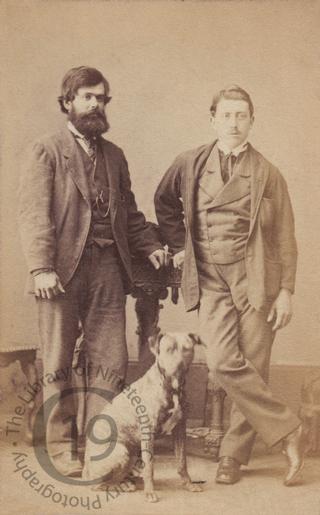
Nicholas Primoraz and Edwin Hayter
In the summer of 1870, two men made an East to West crossing of the Atlantic in a small boat named the City of Ragusa, a converted 20ft lifeboat. The following year, two men made the return voyage to Liverpool in the same vessel. There is a phenomenal amount of misinformation about this double transatlantic crossing on the Internet. I’ve looked as some contemporary reports and I think I’ve pieced together the true story.
On the outbound journey, the Captain was a middle-aged Irishman named John Charles Buckley and his mate was a Croatian named Nikola Primorac (usually Anglicised as Nicholas Primoraz). According to the Times (5 October 1870), the small craft left Liverpool on 2 June 1870, took ten days to reach Queenstown in Ireland, where she spent 4 days under repair, and finally reached Boston on 8 September. ‘There were strong westerly winds almost from the beginning of the journey, and two or three heavy gales.’
According to the Cork Examiner (30 June 1871): ‘For some time the little City of Ragusa continued to attract attention, having accomplished the voyage from here to America in 82 days. Captain Buckley, after having accomplished his extraordinary fete [sic], took passage by one of the homeward-bound steamers and returned to Liverpool. The little City of Ragusa then remained in the keeping of Nicholas Primovez [sic], the solitary associate of Captain Buckley on his voyage, and he determined if he got a companion to make a return passage. […] Mr Edwin Hayter, a native of Newfoundland, but of English parents, consented to be his crew. […] Both men, who had with them a dog, sailed from New York and passed out Sandy Hook on the 23rd of May at 5 o’clock on Wednesday morning.’ Due to favourable winds, the return crossing only took 38 days and the men arrived in Queenstown at midnight on Wednesday 28 June 1871. On 10 July they continued on to Liverpool.
The photograph was clearly taken in Liverpool after the return voyage. A printed caption verso identifies Primoraz as the ‘Master and Owner’ and E.R.W. Hayter as the Mate. The dog’s name was Boatswain (presumably pronounced Bo’s’n). According to the Illustrated Police News (8 July 1871), he was a ‘splendid brindled bull terrier which bore all the suffering of the long journey with as much fortitude as his fellow passengers.’ Some reports say Boatswain was a Newfoundland who was swept overboard on the outbound voyage but this carte disproves that claim. Perhaps there was a different dog on the first crossing, one who was indeed lost on the journey, but if so, its name is not known.
Sadly, Boatswain’s life did not end well, still less the life of his master. On 27 December 1878, the Liverpool Mercury reported on a ‘Sensational Scene in Duke Street.’ ‘Yesterday forenoon, the inhabitants in the neighbourhood immediately adjoining the Sailor’s Home were rather startled by seeing a man rushing about the streets with loaded firearms, evidently intent upon shooting someone. His name was found to be Nicholas Primoraz, tobacconist and stationer, carrying on business at 56, Duke-street, and with considerable difficulty he was secured and locked up. As he is evidently out of his mind, he will be taken to a lunatic asylum. Primoraz is the man who a few years ago sailed across the Atlantic in a tiny boat name the City of Ragusa, his only companion being a dog. This dog yesterday attempted to bite a police constable who snatched a pistol from its master, and was afterwards shot with the same weapon. The faithful animal was not killed by the shot, but was afterwards drowned at the Jordan-street pinfold.’ Primoraz was admitted to Rainhill Asylum on 16 January 1879; he died there on 1 March 1886, aged only 43.
Hayter ended his days in New Zealand but first spent a number of years in England. According to an announcement in the London Gazette (23 September 1879), Edwin Richard William Hayter, a ‘Boat Owner and Letter of Boats on Hire’ of Maidenhead in Berkshire, had recently filed for bankruptcy in the county court. He emigrated to New Zealand in 1893 and died there in 1934.
The boat, the City of Ragusa, was exhibited for many years in the Liverpool Museum but was destroyed by an air raid during World War II.
Photographed by Vandyke and Brown of Liverpool.
Code: 126544




